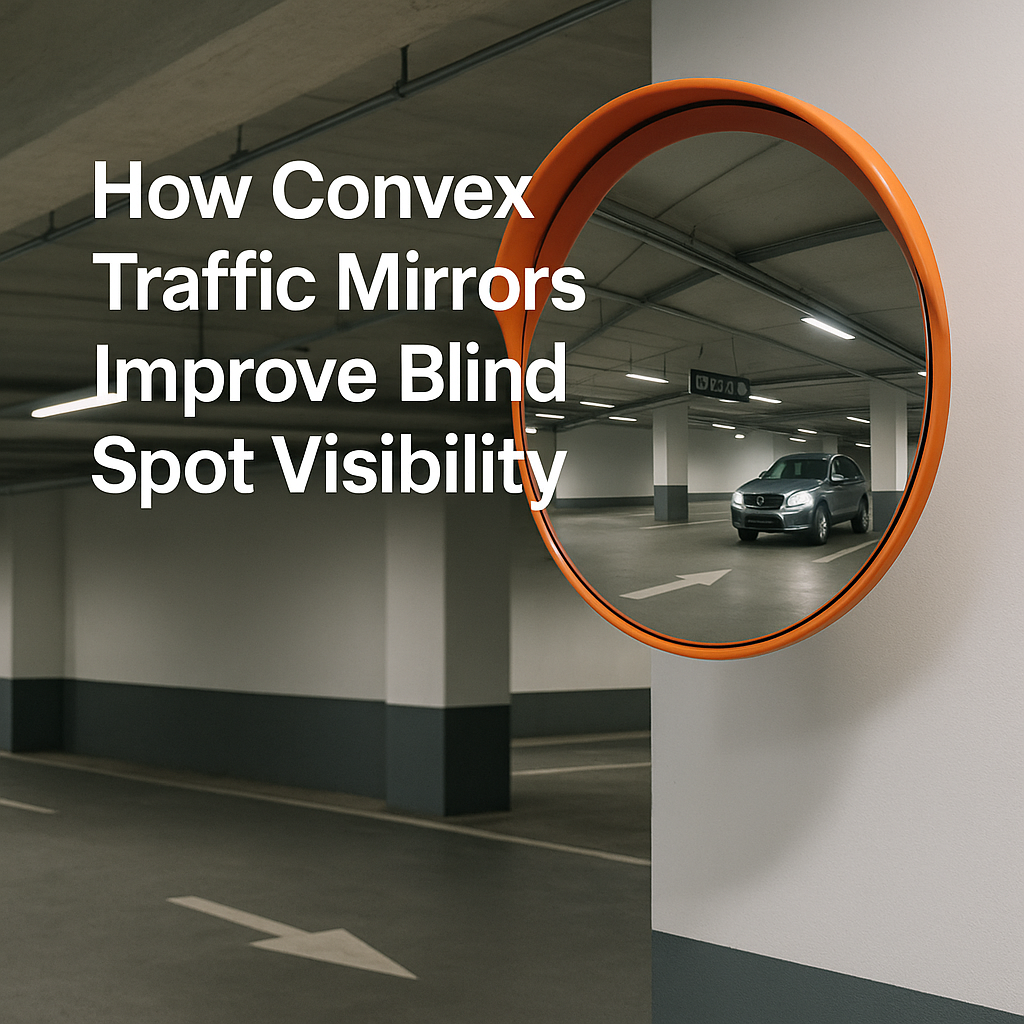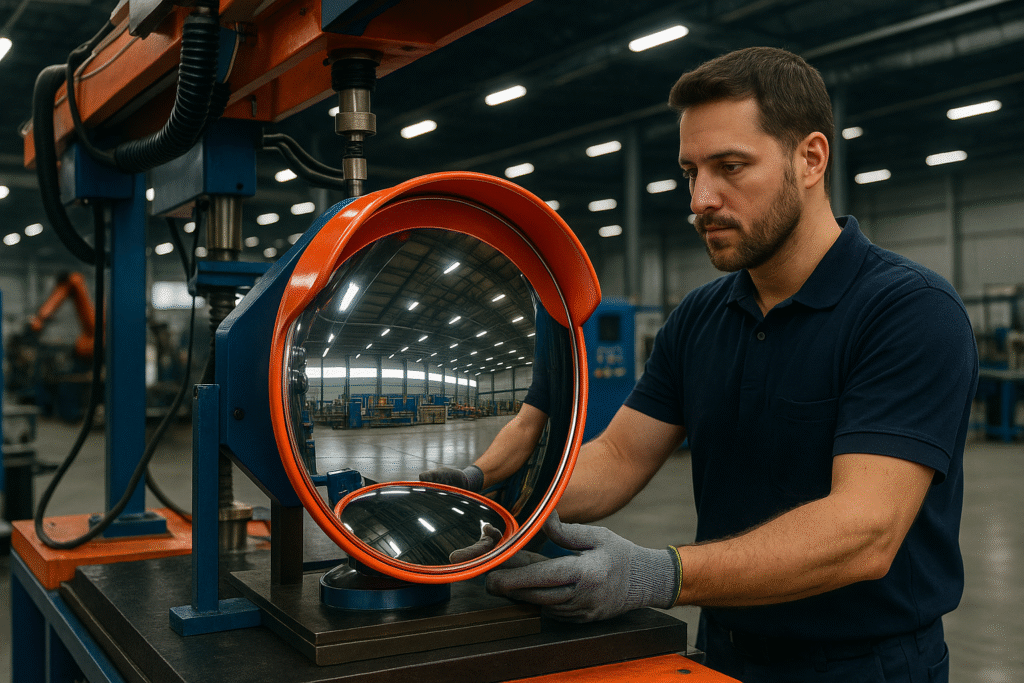Loading docks are among the most active and hazardous zones in commercial and industrial facilities. They involve a continuous flow of trucks, forklifts, workers, and cargo movement in tight spaces, often with limited visibility. One mistake in such a high-risk area can result in serious injury, equipment damage, or costly downtime.
To improve visibility and reduce risk, convex mirrors are one of the most effective safety tools. These mirrors expand the field of view at critical points, helping operators, drivers, and pedestrians make faster and safer decisions. However, correct placement is what determines their true effectiveness.
This article covers strategic placement techniques for convex mirrors specifically in and around loading docks, ensuring optimal visibility, smoother traffic, and fewer incidents.
Why Loading Docks Are High-Risk Zones
Loading docks have multiple hazards happening simultaneously, including:
- Trucks backing in and out
- Forklifts transporting materials in both directions
- Workers on foot carrying out tasks nearby
- Structural obstructions like dock shelters, walls, and trailers
- Tight clearances and blind corners
With this combination of movement and limited sightlines, the chances of collisions or near-misses are high. Proper use of convex mirrors can eliminate many of these visibility problems.

Benefits of Convex Mirrors in Dock Areas
Before diving into placement, here’s a quick recap of what convex mirrors offer in a dock setting:
- Wider field of vision at blind spots and corners
- Early detection of moving forklifts or approaching trucks
- Improved pedestrian awareness for equipment operators
- Faster reaction time for reversing or turning
- Better coordination between drivers and ground staff
When placed correctly, these mirrors become silent safety partners for everyone operating in and around the dock.
Key Placement Zones Around Loading Docks
To get the most from convex mirrors, install them in these high-risk zones:
1. Dock Door Exits
Forklifts often exit from inside the warehouse through dock doors with limited side visibility. Mount convex mirrors just outside these doors, facing outward to show cross-traffic or pedestrians.
Best practice:
Install wall-mounted mirrors at forklift driver eye level, slightly angled downward. If visibility is needed in both directions, use a dual-sided setup with mirrors on each side of the door.
2. Blind Corners Near Dock Walls
Many loading docks have structural columns, sidewalls, or containers that create blind corners. Place convex mirrors on these corners to give operators visibility of incoming or outgoing movement.
Best practice:
Use 180-degree dome mirrors or large circular mirrors with adjustable brackets. This allows fine-tuning the angle depending on seasonal layout or trailer height.
3. Outside Dock Lanes for Reversing Trucks
When trucks back into bays, drivers often have limited rear and side vision. Convex mirrors placed on poles or adjacent buildings help both drivers and spotters assess surroundings more accurately.
Best practice:
Install 26 to 36-inch outdoor-grade mirrors at a height visible from the driver’s side mirror. Ensure it reflects cross-traffic or pedestrians moving behind the truck.
4. Forklift Crossing Paths
Forklift paths that intersect near dock zones should have mirrors placed at the intersection point. This is especially critical where warehouse walls or pallet stacks limit forward visibility.
Best practice:
Use ceiling or wall-mounted mirrors near the crossing point. Reflect both paths equally so drivers on both ends benefit from the view.
5. Pedestrian Walkways and Access Points
Employees often walk near docks to access doors, restrooms, break areas, or offices. These crossing points can be dangerous when forklifts are active. Mirrors help both drivers and pedestrians avoid unintentional contact.
Best practice:
Install mirrors at eye level near pedestrian doors or intersections. Use accompanying signage to alert drivers to the mirror and walkway.
6. Inside Warehouse Near Dock Bays
The area just inside the warehouse near dock bays is another danger zone. With forklifts entering and exiting quickly, mirrors give internal operators visibility before pulling out.
Best practice:
Place indoor-grade mirrors above dock doorways angled into the aisle. Pair with mirrors showing adjacent traffic lanes if available space allows.

Mirror Size and Specifications for Docks
Not all convex mirrors are suited for dock environments. Use these specifications for long-lasting and functional results:
- Material: Use polycarbonate or acrylic for impact resistance
- Size: Minimum 18 inches for indoor corners, 26 inches or more for truck lanes or wide zones
- Mounting: Adjustable brackets for wall, pole, or ceiling mounting
- Coatings: Use anti-fog and anti-scratch surfaces for clear visibility
- Weatherproofing: Outdoor mirrors must be UV-resistant and water-sealed
Ensure mirrors are mounted securely and can withstand vibration, bumps, and regular cleaning.

Installation Tips for Maximum Effectiveness
Mirror placement isn’t just about putting them at random corners. For the best outcome:
- Test each mirror’s position by simulating forklift and truck approaches
- Ensure there’s enough ambient light or install supplemental lighting
- Avoid placing mirrors where glare or shadows reduce visibility
- Angle mirrors downward slightly to avoid reflecting ceiling lights
- Use mirrors in combination with painted safety lines and signs
Involve forklift operators during installation testing. They can give immediate feedback on blind spots and visual clarity.
Common Mistakes to Avoid
When placing convex mirrors in dock areas, avoid these frequent errors:
- Mounting too high or too low for effective visibility
- Using mirrors too small for the viewing distance required
- Skipping mirrors at known high-risk intersections
- Not adjusting mirror angles after installation
- Ignoring damage or dirt buildup over time
Even the best mirrors won’t work if they’re poorly placed, blocked, or left unmaintained.
Maintenance and Inspection
Convex mirrors require minimal upkeep but must be inspected regularly. Add them to your routine safety checklists with tasks like:
- Cleaning with non-abrasive cleaner weekly
- Checking for cracks or warping
- Realigning angles if bumped or loosened
- Ensuring brackets are firmly secured
- Replacing faded or missing safety signage nearby
Routine checks prevent failures during critical moments and ensure mirrors remain an active safety feature.

Final Thoughts
In loading dock environments, visibility equals safety. Convex mirrors are an easy, cost-effective way to prevent blind-spot accidents, smooth traffic movement, and protect workers.
The key is strategic placement based on traffic flow, obstruction points, and daily movement patterns. When placed and maintained correctly, convex mirrors help everyone, drivers, operators, pedestrians, move with more confidence and fewer risks.
Evaluate your dock layout, identify blind zones, and deploy mirrors in the right spots. It’s a simple step that delivers powerful safety results.
Looking for a custom convex mirror manufacturer or supplier? Struggling to find the right factory to bring your vision to life? We’ve got you covered! At our place, we craft top-quality convex mirrors with precision and care. Big or small, your needs are our mission. Let’s launch your mirror project and take your product line to the next level! Click here to contact
